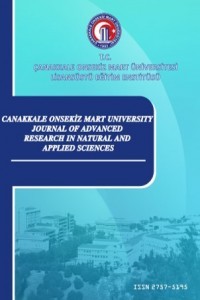Boundary Extraction Based on Dual Stream Deep Learning Model in High Resolution Remote Sensing Images
Remote sensing photogrammetry, orthophotos, deep learning, boundary extraction,
___
- Altınoluk E., Akçay Ö., Kınacı A. C., Avşar Ö., Polat A. B. & Aydar U. (2020). Effects of Orthophoto Band Combinations on Semantic Segmentation. Intercontinental Geoinformation Days (IGD), (pp. 9-12).
- Chen, L. C., Papandreou, G., Kokkinos, I., Murphy, K., & Yuille, A. L. (2014). Semantic image segmentation with deep convolutional nets and fully connected crfs. arXiv preprint arXiv:1412.7062.
- Chen, L. C., Barron, J. T., Papandreou, G., Murphy, K., & Yuille, A. L. (2016). Semantic image segmentation with task-specific edge detection using cnns and a discriminatively trained domain transform. Proceedings of the IEEE conference on computer vision and pattern recognition (pp. 4545-4554).
- Cheng, G., & Han, J. (2016). A survey on object detection in optical remote sensing images. ISPRS Journal of Photogrammetry and Remote Sensing, 117, 11-28.
- Dai, J., He, K., & Sun, J. (2016). Instance-aware semantic segmentation via multi-task network cascades. Proceedings of the IEEE conference on computer vision and pattern recognition (pp. 3150-3158).
- Guo, Y., Liu, Y., Georgiou, T., & Lew, M. S. (2018). A review of semantic segmentation using deep neural networks. International journal of multimedia information retrieval, 7(2), 87-93.
- Han, X., Zhong, Y., & Zhang, L. (2017). An efficient and robust integrated geospatial object detection framework for high spatial resolution remote sensing imagery. Remote Sensing, 9(7), 666.
- Hariharan, B., Arbelaez, P., Bourdev, L., Maji, S., & Malik, J. (2011). Semantic Contours from Inverse Detectors, International conference on computer vision (pp. 991-998). IEEE.
- Kinzie, J., & Kuh, G. D. (2004). Going DEEP: Learning from campuses that share responsibility for student success. About Campus, 9(5), 2-8.
- Kokkinos, I. (2015). Pushing the boundaries of boundary detection using deep learning. arXiv preprint arXiv:1511.07386.
- Kokkinos, I. (2017). Ubernet: Training a universal convolutional neural network for low-, mid-, and high-level vision using diverse datasets and limited memory. Proceedings of the IEEE Conference on Computer Vision and Pattern Recognition (pp. 6129-6138).
- Lee, C. Y., Xie, S., Gallagher, P., Zhang, Z., & Tu, Z. (2015, February). Deeply-supervised nets. In Artificial intelligence and statistics (pp. 562-570). PMLR.
- Maninis, K. K., Pont-Tuset, J., Arbeláez, P., & Van Gool, L. (2017). Convolutional oriented boundaries: From image segmentation to high-level tasks. IEEE transactions on pattern analysis and machine intelligence, 40(4), 819-833.
- Marmanis, D., Schindler, K., Wegner, J. D., Galliani, S., Datcu, M., & Stilla, U. (2018). Classification with an edge: Improving semantic image segmentation with boundary detection. ISPRS Journal of Photogrammetry and Remote Sensing, 135, 158-172.
- Rottensteiner, F., Sohn, G., Jung, J., Gerke, M., Baillard, C., Benitez, S., & Breitkopf, U. (2012). The ISPRS benchmark on urban object classification and 3D building reconstruction. ISPRS Annals of the Photogrammetry, Remote Sensing and Spatial Information Sciences I-3 (2012), Nr. 1, 1(1), 293-298.
- Shen, W., Wang, X., Wang, Y., Bai, X., & Zhang, Z. (2015). Deepcontour: A deep convolutional feature learned by positive-sharing loss for contour detection. Proceedings of the IEEE conference on computer vision and pattern recognition (pp. 3982-3991).
- Shorten, C., & Khoshgoftaar, T. M. (2019). A survey on image data augmentation for deep learning. Journal of Big Data, 6(1), 1-48.
- Xie, S., & Tu, Z. (2015). Holistically-nested edge detection. Proceedings of the IEEE international conference on computer vision (pp. 1395-1403).
- Yu, Z., Feng, C., Liu, M. Y., & Ramalingam, S. (2017). Casenet: Deep category-aware semantic edge detection. Proceedings of the IEEE conference on computer vision and pattern recognition (pp. 5964-5973).
- Yayın Aralığı: Yılda 4 Sayı
- Başlangıç: 2015
- Yayıncı: Çanakkale Onsekiz Mart Üniversitesi
İrem ŞEN DAĞ, Buket GÜNEŞER, Yonca YUCEER
Muhammad Salihu IBRAHİM, Meltem ÇAKMAK, Dursun ÖZER, Fikret KARATAŞ, Sinan SAYDAM
Musa BALKAYA, Suha OZDEN, Hüsnü Serdar AKYÜZ
